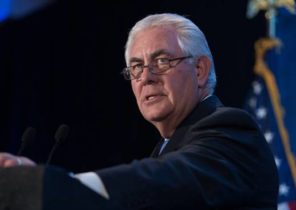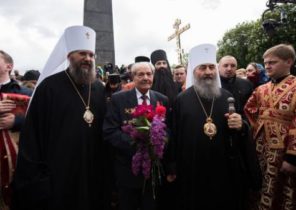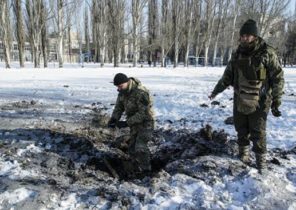
Has huge influence in Russia discussion club “Valdai”, which is called the intellectual base of the Kremlin, held 4-5 April in Moscow hotel “Hilton” conference on the topic of Russian-Chinese relations. The ambition of the organizers testified its title: “Russia and China: facing the challenges of global change”. That it coincided with the meeting of leaders of China and the United States, which began on April 6 at Florida, probably an accident, however, against this background, the conference has received a special resonance. Its organizers intended to convince the elites of the two countries that the Union of Moscow and Beijing is heavy. Meanwhile, these intentions came to nothing: a failure on all fronts.
Russians are convinced that the world in which the leading role played by the opinions, values, style of thinking and actions of the West, and Western order, came to an end. Minister Lavrov spoke about this at the Munich conference, and most recently in an interview with The National Interest. But what will replace it? According to the Russians, on the spot, as they say, a unipolar world formed a system in which a counterweight to the US will serve as the Asian block. It will be based on the Alliance of Russia, China and India, and they will gravitate to the smaller States — Pakistan, South Korea or even Japan and Iran. This is the dream of the Russians.
The same Lavrov has openly talked about this plan during a recent meeting with senior staff and high ranking officers of the Russian General staff. You should pay attention that there is absolutely no theme of Europe. The Russians believe that the question is, will it remain in the camp, which will lead US, not solved. What will be its geopolitical position, will play that will unfold in this century, the struggle for influence and status. We will see the confrontation of Washington, watching, as it weakens the position of world leader, with new tigers, among which not the last role due to its military capabilities, diplomatic skills and raw material inventories to play Moscow.
For the Russian scenario-the dream began to materialize, to appear and to gain political value of the axis Moscow — Beijing — Delhi, and with it recently there were complications. It all started perfectly. India bought a huge amount of Russian arms and increased the volume of orders. First there were tanks in the beginning of the century the Indians acquired from the Moscow machines 310 T-90S ($800 million), and in 2007 ordered another 347 pieces (1.24 billion). In 2004, India bought the aircraft carrier “Admiral Gorshkov” (2,33 billion) last year, the countries agreed on the supply of Russian frigates of project 11356 and the joint creation of combat helicopters (from 2.5 to 5.8 billion). A contract was signed for the purchase of new tanks and helicopters, maintenance of aircraft and the construction of new frigates.
India was the largest buyer of Russian arms, but recently, the collaboration started to limp. In late March, the Russians announced that a joint Russian-Indian programme to develop military transport aircraft frozen: the parties are unable to reach an agreement. Last week the chief of staff of the Indian air force Marshal Birender Singh Dhanoa (Birender Singh Dhanoa) said that his country had started negotiations with the European concern Airbus on purchase of transport aircraft medium-range missiles. A complete disaster ended the Russian-Indian conference which is in early April, spent two influential analytical center of the Russian international Affairs Council and international Fund for Vivekananda. The former commander of the land forces, which oversees the work of the Indian Foundation abruptly announced that India is anxiously looking at the cooperation between Russia and Pakistan in the military sphere, and the rise of China (which made the Alliance with Islamabad is one of the foundations of its position in Asia), because it can disrupt the balance of power on the continent. Participated in the discussion, the former commander of the Eastern fleet of India has placed points over “i”, indicating that “Russia has the right to sell arms to Pakistan, but in this case it must be prepared for the fact that the formula of cooperation “business as usual” will lose its power.”
No less alarmed the Indians that Russia is ready to start negotiations with the Taliban, in which the role of the facilitator needs to play Islamabad. In India, the ruling conservative party “Janata” in such a situation, most likely, will choose “Atlantic option” and will strengthen economic and military Alliance with Washington. Of course, it will be possible, if the new American administration will follow the example of George W. Bush and will make an Alliance with India one of the pillars of its policy in Asia.
India was the largest importer of Russia not only in the field of armaments, she bought most in the world of Russian gold. But here the situation is not the best way. As reported recently by Reuters, in 2016, the Russian Central Bank bought 201 tons of gold — more than any country on earth combined. Analysts suggest that in 2017, Moscow will not reduce the pace of purchases and will purchase about 200 tons. Pessimists conclude from this that the Russians are preparing for a large military operation and knowing about the impending consequences of accumulating “hard reserves”. There is also a less gloomy explanation: India was the world’s largest importer of this metal sharply reduced the volume of purchases. At the same time, the Russian oligarchs, the “working of gold” (Mordashov), significantly increased the volume of production, so that the friends of the first man in the Russian state needed the help.
In General, the cooperation between Moscow and new Delhi looks rather pale. The volume of Russian exports in 2016 amounted to 7.7 billion dollars (2012 — 11), this figure far from the hundreds of billions that are on the trade with China. (The volume of imports from India were even lower.) Now everything else is added to political disputes. Observing the differences between India and China on the background of Chinese contacts with Islamabad, the Russians in recent months, several smedile accents and were more likely to say no about the axis Moscow — Delhi — Beijing, and on the strategic Russian-Chinese cooperation.
On the eve of the Moscow conference of the Valdai club published its latest, 63rd, “note”, with the theme of the Union of China and Russia. This is a very interesting material. Even though he wrote his Australian Glenn Dizen (Glenn Disen), it presents the Russian point of view. The author of the text believes that regional blocks of integration and cooperation can be viable only when the participants agree to, as he puts it, “asymmetrical interdependence”. On the one hand, in his opinion, it contributed to the success of European integration, and on the other was one of the causes of the current decline in the EU when one country, Germany, took a dominant position. That type of situation creates the temptation for the strong player who wants to use the Union for their own purposes and to take all related its existence benefits. This, in turn, gives rise to centripetal tendencies and the discontent of the weaker players, and as a result leads to a weakening of the Alliance (as in the case of the EU) or its collapse (the cooperation between the EU and Moscow). So in short form, looks like the diagnosis of the causes of the crisis on the line Brussels — Moscow.
The Western world did not want to establish partnerships, and tried to take the contacts this role and to impose its economic and cultural orientations model. The Russian elite could not agree to that, as a result of Russian foreign policy after 2008 have shifted from the West to the East. Without going into reflections on how reliable this estimate, one has to wonder how to extend this model to relations between Moscow and Beijing?
Despite the obvious differences in economic, human and financial potentials of the two countries in Beijing, as suggested by Dizen, should not be in relations between the two countries in a dominant position. A much better option (of course, for Russia) will be a conscious rejection of Beijing’s and giving Russians certain privileges. What does it mean? A strong Union of the Chinese economic and financial power and military superiority of the Russian diplomatic experience. This tandem will be able to attract other regional powers. In short, passive active China and Russia will go hand in hand. Spiteful critics can say that the tail will wag the dog, but look Russian dreams and goals for the twenty-first century.
The problem is that the Chinese imagine the mutual relations, to put it mildly, a little different. And here we return to the Moscow conference, which I mentioned at the beginning. Calls one of the leaders of the club, Sergei Karaganov, who opened the event with remarks in the above spirit, the Chinese called, no doubt, a legacy of geopolitics. They drew the attention of the Russians that the world is now engaged with other issues, for example, the creation of a single multilateral free trade platform, and not the formation of military-economic alliances against third countries. One of the Chinese participants of the conference also drew attention that in the past Russia and China have “already tried three times to create a military Alliance, and the three moved away from each other. You need to realize it”.
If we turn to the origins of the term, is in parentheses to note that one recent public opinion poll gave interesting results. It turned out that the Russians believe the best candidates in husbands just Chinese. For ethnic Russians in the far East this does not Bode well.
The conference of the club “Valdai” was not completed in the expected success, so the Russian press writes about it a little. It was distinctly clear that China, which unlike Russia has benefited from globalization, it is not eager to build any anti-American alliances or Asian axis. This is indicated by concrete facts. The creation of institutions aimed to provide a counterbalance to those who, in the opinion of Russia, are under the control of the West, for example, the Asian development Bank, China committed to send within seven years of two billion dollars. Meanwhile, in private projects as the silk road Fund, Beijing is investing tens of billions of dollars (to Fund 40 in the Asian infrastructure investment Bank — 50).
It seems that the Russian dream of making the Asian unit may have to remain only dreams, and expansion will continue. The Chinese expansion.







